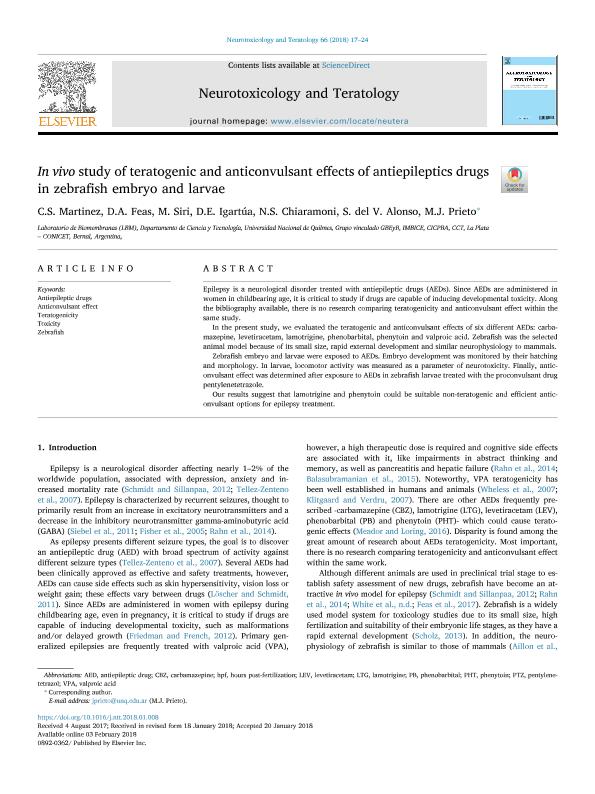Artículo
In vivo study of teratogenic and anticonvulsant effects of antiepileptics drugs in zebrafish embryo and larvae
Martinez, Carolina Soledad ; Feas, Daniela Agustina
; Feas, Daniela Agustina ; Siri, Macarena
; Siri, Macarena ; Igartúa, Daniela
; Igartúa, Daniela ; Chiaramoni, Nadia Silvia
; Chiaramoni, Nadia Silvia ; Alonso, Silvia del Valle
; Alonso, Silvia del Valle ; Prieto, Maria Jimena
; Prieto, Maria Jimena
 ; Feas, Daniela Agustina
; Feas, Daniela Agustina ; Siri, Macarena
; Siri, Macarena ; Igartúa, Daniela
; Igartúa, Daniela ; Chiaramoni, Nadia Silvia
; Chiaramoni, Nadia Silvia ; Alonso, Silvia del Valle
; Alonso, Silvia del Valle ; Prieto, Maria Jimena
; Prieto, Maria Jimena
Fecha de publicación:
03/2018
Editorial:
Pergamon-Elsevier Science Ltd
Revista:
Neurotoxicology and Teratology
ISSN:
0892-0362
Idioma:
Inglés
Tipo de recurso:
Artículo publicado
Clasificación temática:
Resumen
Epilepsy is a neurological disorder treated with antiepileptic drugs (AEDs). Since AEDs are administered in women in childbearing age, it is critical to study if drugs are capable of inducing developmental toxicity. Along the bibliography available, there is no research comparing teratogenicity and anticonvulsant effect within the same study. In the present study, we evaluated the teratogenic and anticonvulsant effects of six different AEDs: carbamazepine, levetiracetam, lamotrigine, phenobarbital, phenytoin and valproic acid. Zebrafish was the selected animal model because of its small size, rapid external development and similar neurophysiology to mammals. Zebrafish embryo and larvae were exposed to AEDs. Embryo development was monitored by their hatching and morphology. In larvae, locomotor activity was measured as a parameter of neurotoxicity. Finally, anticonvulsant effect was determined after exposure to AEDs in zebrafish larvae treated with the proconvulsant drug pentylenetetrazole. Our results suggest that lamotrigine and phenytoin could be suitable non-teratogenic and efficient anticonvulsant options for epilepsy treatment.
Palabras clave:
ANTICONVULSANT EFFECT
,
ANTIEPILEPTIC DRUGS
,
TERATOGENICITY
,
TOXICITY
,
ZEBRAFISH
Archivos asociados
Licencia
Identificadores
Colecciones
Articulos(CCT - LA PLATA)
Articulos de CTRO.CIENTIFICO TECNOL.CONICET - LA PLATA
Articulos de CTRO.CIENTIFICO TECNOL.CONICET - LA PLATA
Articulos(IMBICE)
Articulos de INST.MULTIDISCIPL.DE BIOLOGIA CELULAR (I)
Articulos de INST.MULTIDISCIPL.DE BIOLOGIA CELULAR (I)
Citación
Martinez, Carolina Soledad; Feas, Daniela Agustina; Siri, Macarena; Igartúa, Daniela; Chiaramoni, Nadia Silvia; et al.; In vivo study of teratogenic and anticonvulsant effects of antiepileptics drugs in zebrafish embryo and larvae; Pergamon-Elsevier Science Ltd; Neurotoxicology and Teratology; 66; 3-2018; 17-24
Compartir
Altmétricas



